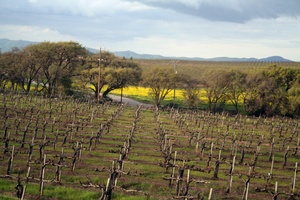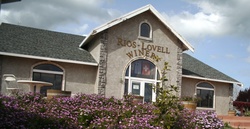Topography
Livermore Valley is one of the coastal intermountain valleys that surround the San Francisco Bay depression. The valley floor is approximately 15 by 10 miles (24 km × 16 km). Starting in the east, the watershed area of Livermore Valley is bounded by the Altamont Hills and Crane Ridge, to the south by Cedar Mountain Ridge and Rocky Ridge, in the west by the Pleasanton Ridge, and in the north by the Black Hills. The valley's geographic location is generally the area covered by the political boundaries of Murray and Pleasanton townships. The elevation where the vineyards are cultivated starts at 650–800 ft (198–244 m) above sea level and slopes toward the valley floor to about 450 ft (137 m) above sea level. The main streams in the valley are the Arroyo Mocho, Arroyo Del Valle, and the Arroyo Las Positas which are formed by the watershed run-off of the previously named ridges.
The drainage pattern is well developed with the streams flowing in a westerly direction. These streams converge about one mile west of the town of Pleasanton and form the Arroyo de la Laguna. This stream in turn joins Alameda Creek and empties into San Francisco Bay. Livermore Valley possesses a predominately gravel based soil and lies on a unique east–west orientation, unlike many other winegrowing valleys. [1]
Climate
Livermore Valley has a moderate coastal climate which is conducive to the growing of grapes, especially the sauterne type grapes and several premium red varieties. The moderate climate is a result of its proximity to the San Francisco Bay and the Pacific Ocean. The cool marine winds and the morning fog are important factors in temperature control during the growing season and in keeping the area relatively frost free during the early spring. The wine grapes grown in Livermore Valley thrive on the cool nights and warmer days. The greatest part of the vineyard acreage is in Region III as classified by the University of California at Davis system of heat summation by degree-days. A small portion of the area within Livermore Valley is classified as Region II. Due to a reliable onshore afternoon/evening breeze off of the San Francisco Bay a wide fluctuation in temperature between sites and a large diurnal temperature swing occur. Livermore Valley is considered a Winkler Region III grape growing zone with temperatures comparable to northern Napa Valley appellations such as St. Helena and Calistoga. [1]
The average rainfall is 14.45 in (367.03 mm). The rain falls mainly during the winter and early spring. There is little or no precipitation during the summer months. With the large increase in population in the Livermore Valley over the past twenty years, the water table has been lowered to a point where the vines no longer are able to depend on a constant water supply from that source. Since the completion of the Del Valle Dam and the filling of the Del Valle Reservoir, both the Arroyo Mocho and Arroyo Del Valle contain water released from the reservoir almost year-round where formerly they were dry by early summer. The South Bay Aqueduct, completed in 1967, provides overhead sprinkler irrigation for some of the vineyards. This type of irrigation is also used for heat suppression and frost protection as well as supplemental watering. The temperature of Livermore Valley is moderate during the winter and moderately high in the summer. The average high is 72.9 °F (22.7 °C) and the average low is 45.3 °F (7.4 °C). Temperatures in the summer have exceeded 100 °F (38 °C) and the lowest temperature recorded in the winter was 19 °F (−7 °C). The extremes rarely last more than a few days before the marine air asserts its normal pattern. The growing season, March through early November, is long enough to assure crop maturity. The average number of growing days is 254. After evaluating the petition and comment, ATF has determined that due to the topographic and climatic features of Livermore Valley, it is distinguishable from the surrounding areas. [1]
Soil
Soils are a distinguishing feature of the Livermore Valley viticultural area. The main soil type is the Yolo-Pleasanton associations with the Livermore gravelly and very gravelly series being prominent in the southern portion of the valley. The expansion area encompasses a geographical area significantly larger than the current Livermore Valley viticultural area; for both areas, the underlying geologic formations and the geological factors in soil formation are the same. Thus, the soils in the expansion area are consistent with those of the original viticultural area. The original Livermore Valley viticultural area and the expansion area developed on the same geologic formations. Those formations include Pleistocene, alluvial, mostly nonmarine terrace deposits on the basin floor; Pleistocene, Pliocene, Miocene, and Cretaceous sandstone, shale, gravel, and conglomerate in the northern, eastern, and western hills; and Franciscan Complex fragmented and sheared sandstone in the southern hills.
The geological forces that formed the topography and soils in the expansion of the Livermore Valley viticultural area are the same as those that formed the topography and soils of the original Livermore Valley viticultural area. Uplift and subsidence along several earthquake faults (among them, the Calaveras and Pleasanton faults to the west, the Greenwood fault to the east, and the Livermore and Tesla faults in the center of the valley) have shaped the region's topography. Erosion and weathering of base material on the slopes and deposition of sediment carried in runoff onto the valley floor have, over long periods of time, formed the soils of the region. [3]
A portion of the Livermore Valley floor within the current viticultural area also includes the Positas-Perkins association (shallow gravelly loam on terraces) and the Clear Lake-Sunnyvale association (shallow clay in basins and on terraces).
Soils on the slopes of the current viticultural area and recorded in the survey include the Millsholm-Los Gatos-Los Osos association (well drained to excessively drained soils that have low fertility, on moderately sloping to very steep slopes), the Altamont-Diablo association (well drained to excessively drained, clayey soils that have moderate or high fertility, on rolling to steep slopes), and the Vallecitos-Parris association (well drained to excessively drained, shallow loam and gravelly loam on steep or very steep slopes). The ‘‘Soil Survey of Alameda Area, California’’ and the ‘‘Soil Survey of Contra Costa County, California,’’ by the United States Department of Agriculture, Soil Conservation Service, published in 1977, both record that the same soils were mapped in the expansion area and in the current viticultural area. Although the Altamont-Diablo and Clearlake-Sunnyvale associations in Alameda County and the Altamont-Diablo-Fontana and Clearlake-Cropley associations in Contra Costa County were mapped along the boundary of the two soil survey areas, the soils are virtually identical. The differences in soil names are the result of improvements in the classification of the soils, particularly modifications or refinements in soil series concepts.
Regarding vineyards, the soils in the expanded Livermore Valley viticultural area are different from those in surrounding areas to the north and east; they are on the only sites where vineyards are suited in the immediate vicinity because of steep terrain, population density, and other limiting factors. To the north and east of the boundary, the soils transition into the Brentwood-Rincon-Zamora association (level, well drained clay and silty clay loam on alluvial fans) and the Marcuse-Solan-Pescadero association (nearly level, poorly drained clay, loam, and clay loam on basin rims). Although suited to vineyards, these soils differ from those in the current Livermore Valley viticultural area and the expansion area. [3]






